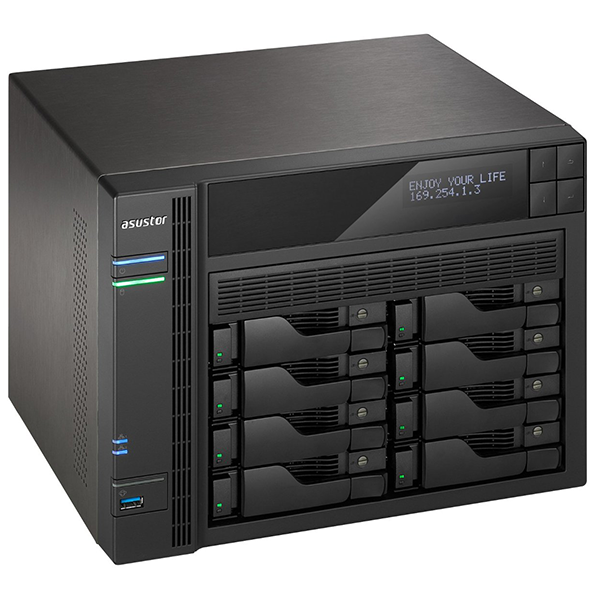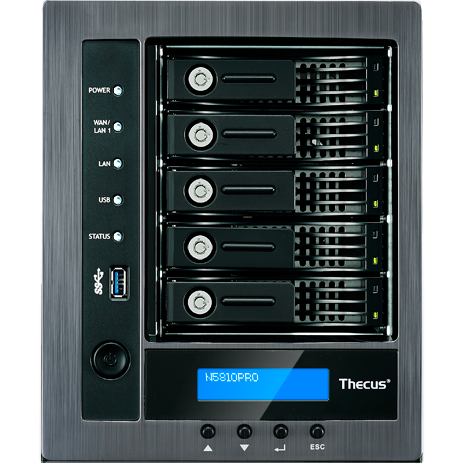QNAP TS-453mini NAS Review
Qnap takes a vertical approach to reduce noise, and making for a small office NAS that fits in tighter spaces.
Why you can trust Tom's Hardware
4-Corner Performance Testing
Sequential Data Transfer by Size
Regardless of all the extra features, the TS-453mini is still an NAS, and eventually you will want to read and write data to it. In the benchmark results below, we compared the QNAP TS-453mini against four other four- and five-bay systems. The prices vary among all of the systems, with some costing more than the TS-453mini and some costing less. All of the devices were armed with 4TB Seagate NAS hard disk drives. RAID 5 was also used across the field of products.
In all but one test, we use one gigabit-Ethernet port back to a Netgear S3300-52X 100/1000/10000 switch. We use a Quanta MESOS CB220 server on the other end to administer the workloads. The MESOS CB220 connects to the network via 10GbE Twinax.
Before we jump into the real-world workloads, we must first evaluate the systems with synthetic tests. This helps us understand where a product is strong and where manufacturers need to optimize performance.
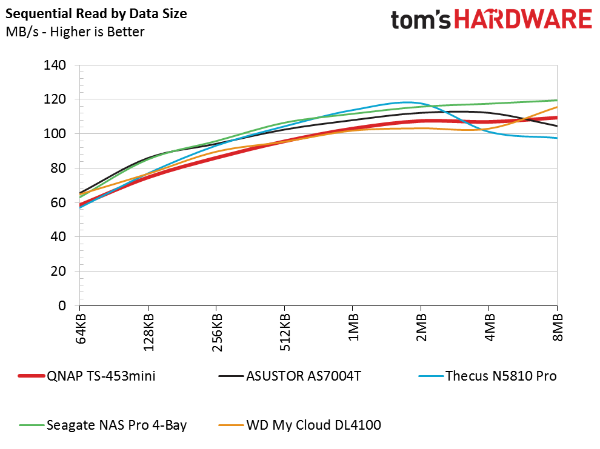
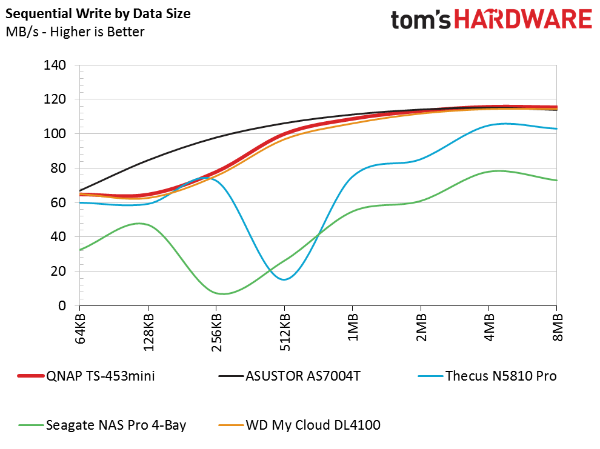
The QNAP TS-453mini delivers consistent sequential performance across the block size range. We didn't observe any wild dips when reading or writing. As you can see in the charts, many of the systems deliver around the same sequential performance. The ASUSTOR AS7004T does have a leg up on the other products in some of the write tests, but it's also the most expensive model, costing nearly twice as much as the lowest-priced system in the charts today. The QNAP TS-453mini sits in the middle of the price range.
Random-Data Transfer by Size
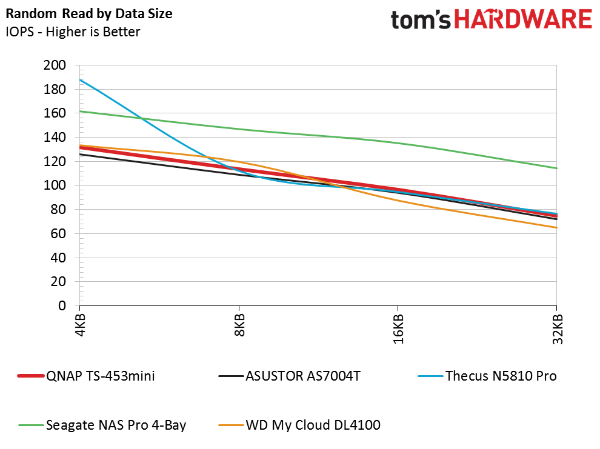
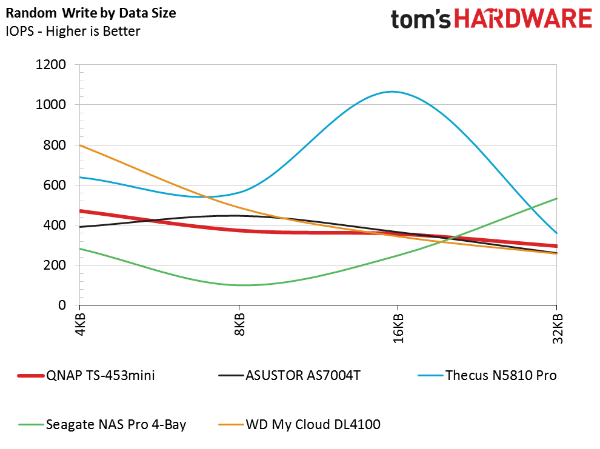
Delivering consistent sequential performance is easy compared to the explosive nature of random data. Most of the data you transfer to your NAS is sequential in nature. Movies, music and pictures — the staples of NAS storage — are all sequential. As these systems became more powerful, they moved closer to the PC. In some configurations, they are the PC. Applications read and write a lot of random data. If you use a NAS as a secondary drive that holds programs that you run over a mapped drive or iSCSI, you are using a lot of random data.
We should always see a drop in the random charts as the performance lines move from the left (very small files) to the right (larger files). The TS-453mini performs as expected in both random tests but isn't the highest-performing across the board. The TS-453mini does give users the option of using an SSD for random-read cache. Users can also use an SSD to cache sequential data, but this isn't an optimal use for the flash, a resource that costs considerably more than hard disk drives.
Sequential Performance
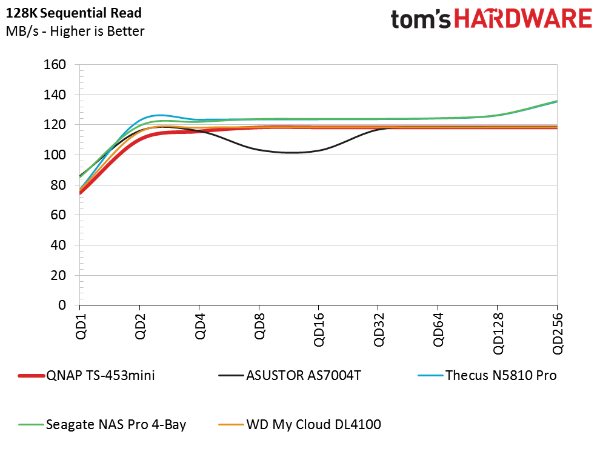
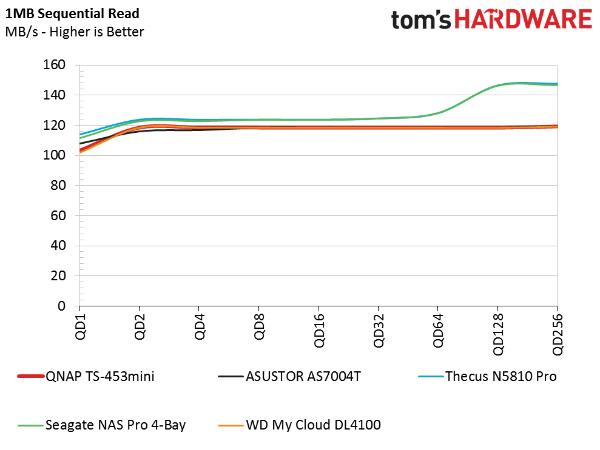
In an office environment, the NAS is often accessed by many users at the same time. This increases the stress on the system. Each new transfer increases the queue depth. Again, we get nice smooth performance from the TS-453mini that is comparable with the other systems in the comparison.
Get Tom's Hardware's best news and in-depth reviews, straight to your inbox.
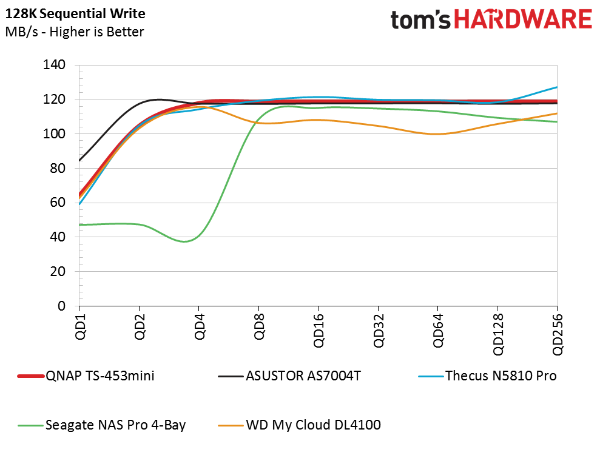
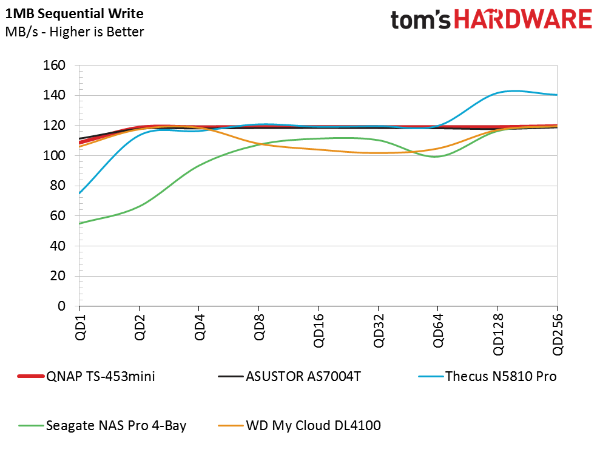
Writing data at varying queue depths is more difficult for many NAS appliances. When we get to high queue-depths, the sequential data becomes random because we're pulling small pieces of data from the disks and from different locations on the platters.
Random Performance
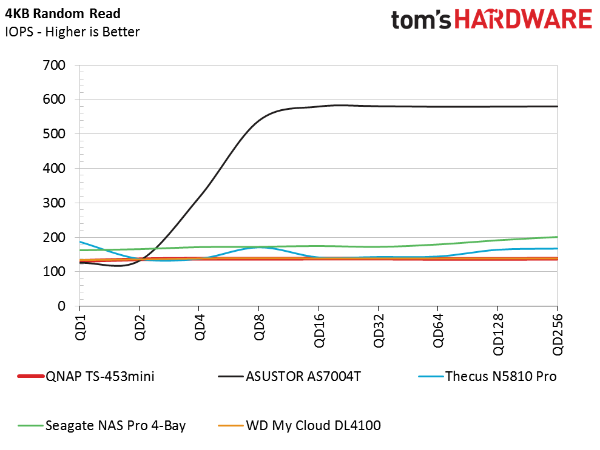
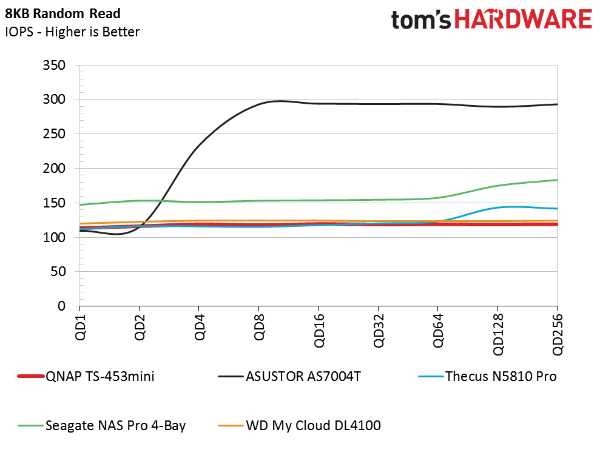
The ASUSTOR AS7004T dominates this test, and there is a reasonable explanation for that. The AS7004T uses a Core i3 desktop processor and not an Intel SoC low-power chip like the other systems do. The Celeron J1900 in the TS-453mini is a powerful processor, but it isn't Core-class.
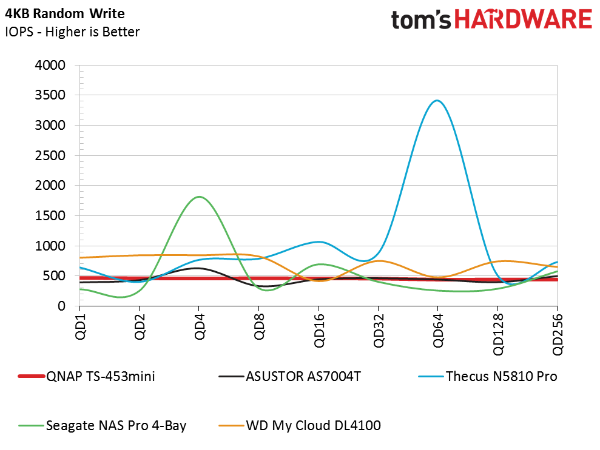
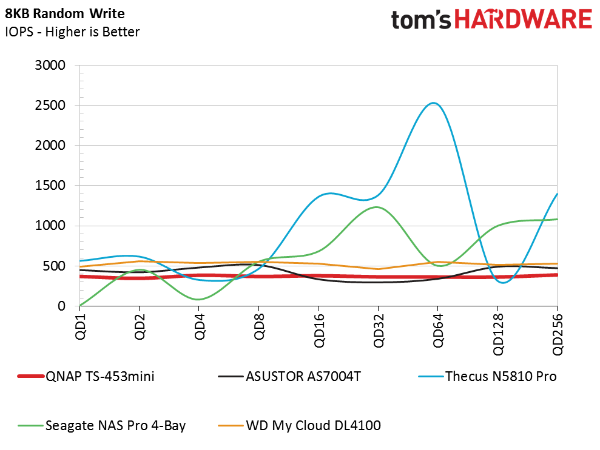
Some of the systems in the charts turned in unpredictable write performance in our synthetic tests. This comes from the cache in the systems where data is buffered in DRAM and the amount of time the system was subjected to the workload. We're working to contain the wild shifts, and our extended tests seem to have done the trick. This will be the last review with the older models tested using the older write tests.
Sequential Mixed-Data Sweep
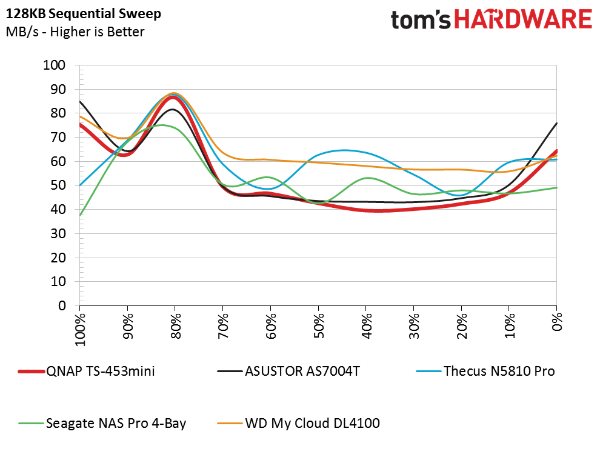
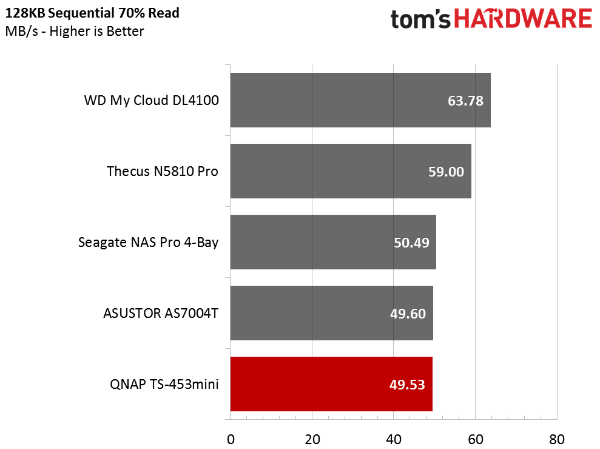
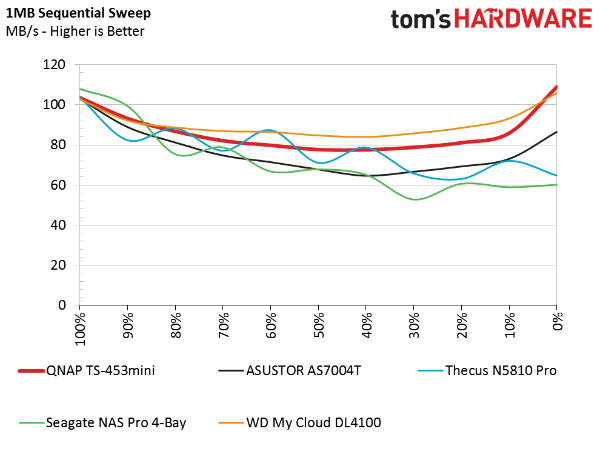
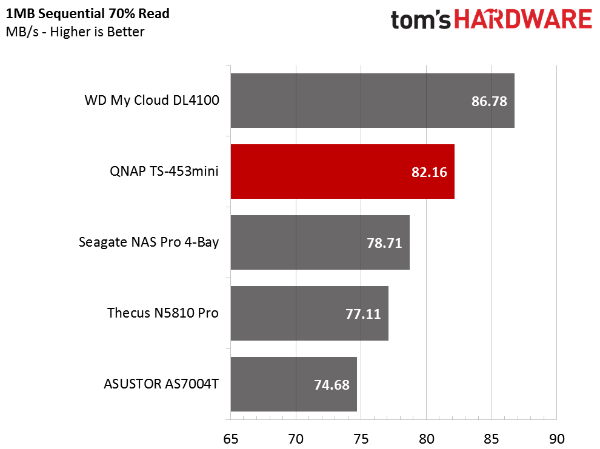
The data-sweep tests show mixed read-write IO performance. We measure two block sizes for sequential and two block sizes for random transfers. Here, we see that a lot can change between two traditionally tested sequential block sizes in the 70 percent read mix. Smaller files put more load on the system and require more IOPS to complete. The TS-453mini compares well against the other products in the chart.
Random Mixed-Data Sweep
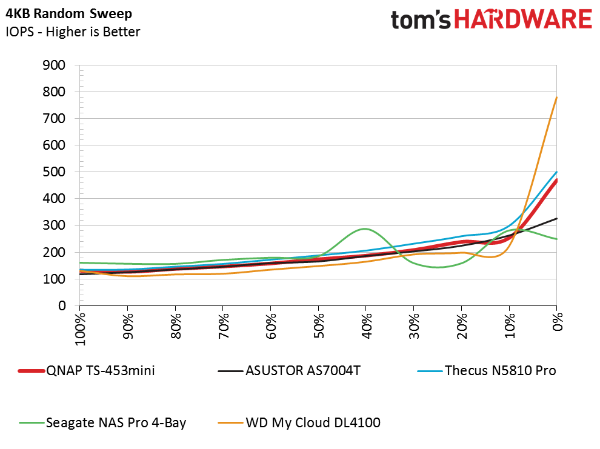

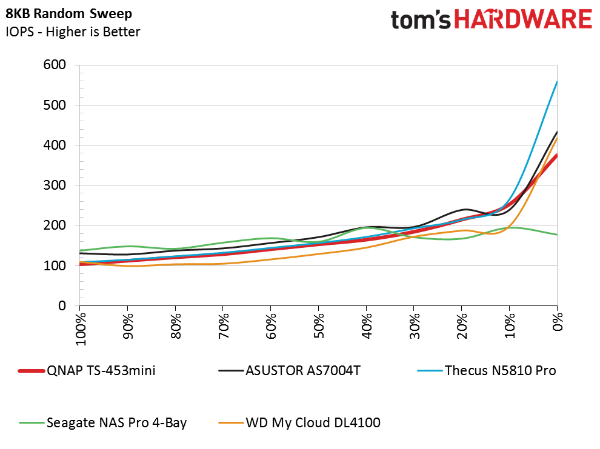
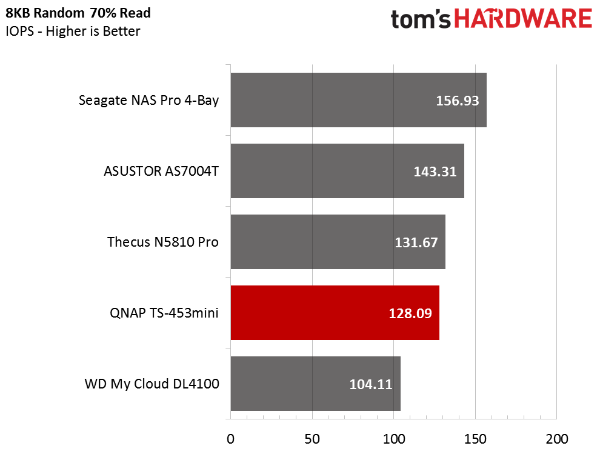
The random sweeps run just like the sequential sweeps but here use 4KB and 8KB blocks. The 4KB blocks make up the majority of Windows read-and-writes when the applications are held on the NAS and accessed over iSCSI. VMware virtual machines are tuned for 8KB random blocks.
The TS-453mini gives us another solid performance with increasing IOPS as we add more random data writes. As we add more writes to the mix, the internal cache aids in increasing the IOPS until we get to 100 percent writes with heavy cache.
Current page: 4-Corner Performance Testing
Prev Page Software Next Page SMB, iSCSI And Standard Server Workloads
Chris Ramseyer was a senior contributing editor for Tom's Hardware. He tested and reviewed consumer storage.
-
thebigt42 $140 just for 8 gig of ram vs 2. That is nuts! I bet they lock down the 2g version so you cant change the ram yourself too.Reply -
astonerii You keep changing the GB on these things. The 8GB is 4GB several times and the 2GB is 4GB at least once.Reply
Really too bad the prices are so high for these things, but they are niche items I guess. I would like to have one, but prices are too high for my want. -
Haravikk Every time a NAS ships with an external power brick of dubious origin I just can't fathom why; while a power brick is a bit easier to replace if it fails than an internal PSU, if they used a standard PC type (e.g- an SFX PSU) then it needn't be that hard. Better yet, a device in this size could easily stand to be a little taller if it meant it could accommodate a pair of slim PSUs such as those common in servers (for redundancy).Reply
Aside from often coming from an unknown source, and being easily the most commonly failing component (more so than hard-drives in my experience), power bricks just destroy any aesthetics that a company tries to put into their "small" devices; hint, if a device is only small because you've made components external, then it's not small, it's badly designed.
Sorry, but it's a real annoyance for me, and the reason I'd rather build a NAS in a small(-ish) PC case as I just don't trust power bricks at all, and for an always-on data storage device that's a pretty big negative. -
Uneventful I am would really like to know more about the Home Theater possibilities of this NAS. The article mentioned that it came with a remote, but that was all. I would like to know a couple of different things: What application or interface it uses if you hook it up to a TV via HDMI and use the remote? What sort of files can it play back? Does the HDMI 1.4a port support 4K?Reply
I have a older QNAP NAS myself and I know that it can run the Plex Server, but is the TS-453mini able to transcode fast enough with the hardware transcoding for watching 1080p on a client? Can you run it as a Plex server and have it playback on the TV at the same time? Does it have support for outputting DTS or DD streams? I would really like more details about how this NAS could be used in a home theater. -
CRamseyer I'm working on a software overview article for each of the major NAS companies right now. There is a lot to go over for each.Reply
The two most common for home theater use are XBMC and KODI. KODI is just the newer version of XBMC. The software supports 7.1, DTS, Dolby, the HD versions and so on. I use KODI to play back 1:1 Blu-Ray ISOs and it works great.
The system can run Plex Server and it's fast enough to transcode on the fly. -
jakjawagon Reply$140 just for 8 gig of ram vs 2. That is nuts! I bet they lock down the 2g version so you cant change the ram yourself too.
Actually they don't. While they recommend you only upgrade using the overpriced kit they'll sell you, it is compatible with standard laptop DDR3 RAM and easily upgradeable.
I bought a TS-451 a few months ago (pretty much the same specs but half the RAM and a CPU with fewer but higher clocked cores, and a more traditional design), and am mainly using it as a media server. Apart from one squeaky drive (salvaged from an old laptop and due to be replaced when I can afford it), I'm very happy with it. Fast enough for my needs, and very configurable even though default settings work well. -
Dyason ReplyI'm working on a software overview article for each of the major NAS companies right now. There is a lot to go over for each.
The two most common for home theater use are XBMC and KODI. KODI is just the newer version of XBMC. The software supports 7.1, DTS, Dolby, the HD versions and so on. I use KODI to play back 1:1 Blu-Ray ISOs and it works great.
The system can run Plex Server and it's fast enough to transcode on the fly.
Fantastic to hear it runs Plex Server. Curious if it will run Plex Theatre for playback as I prefer this over XBMC and KODI. Does it just run normal linux apps for playback? -
CRamseyer https://www.qnap.com/i/en/app_center/Reply
The link goes to a list of applications that are already in the App Manager. Plex Theater is on the list. -
mwituni As an existing QNAP user, I don't know how any QNAP NAS's can be seriously considered for any awards, nor why they do so well on reviews They entice buyers with fancy options, but are not interested in developing applications users need.Reply
SVN (Subversion Source Control) is the most popular and source control software in use, yet QNAP have been promising a proper SVN-server application since 2009, and still not delivered! How can users take them seriously - they're obviously not interested in developing applications the community needs, only the minimum needed to trick buyers into purchasing and evaluators to award prizes. They claim you can install SVN by an outdated method - which is very risky and outdated by a few years, and in my experience does not work at all.
They have a GIT client, so can claim they "have" source control applications. But no SVN support.
Their marketing department needs to kick the development team into gear.
-
Rop Hi guys, i own a 453 Mini and it works great for my needs.Reply
Wish to know if anyone can explain in better detail about why there are so many reports on the Intel Celeron J1900 accesing more then the 8GB ram that are in the spec sheet for the procesor, as many haave installed 16GB and claim it to be fully accesable and usable. And has anyone actaully tested this to be 100% certain that i can in fact accesss more ram then Intel states?
Thanks in advance for you contribution.
